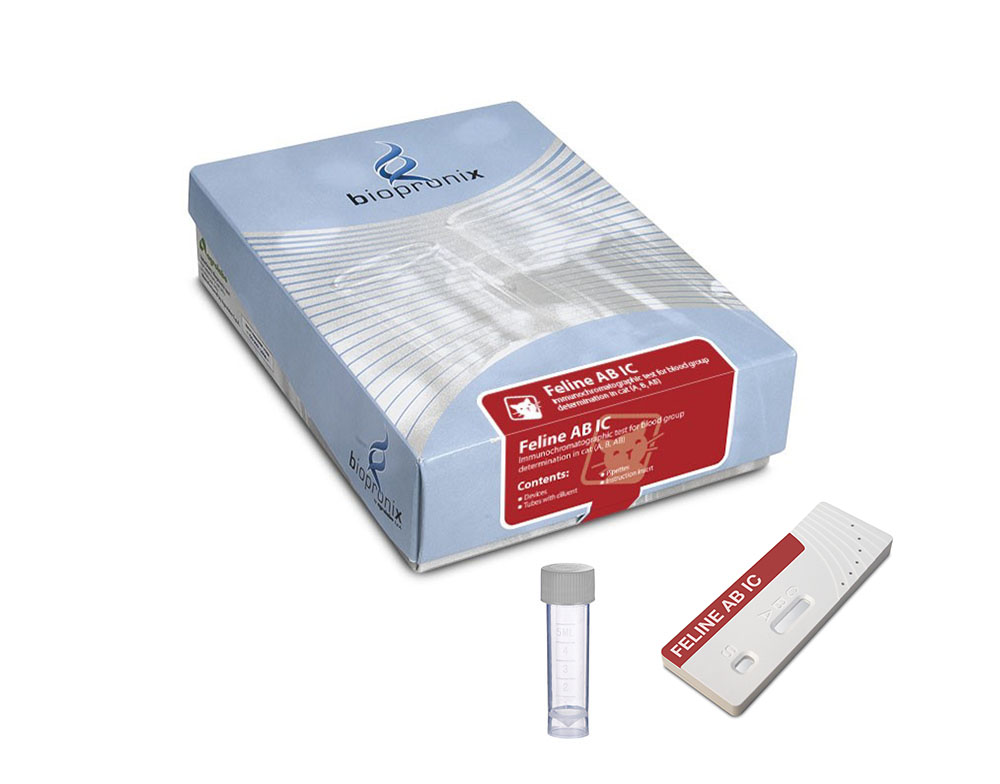Feline AB IC
Test for the rapid determination of blood type in cat whole blood with new monoclonal antibodies
Feline AB IC is a rapid single-membrane immunochromatographic test for the determination of feline blood group (A, B, AB) with new monoclonal antibodies
10/20 TEST
in 5 minutes
In cats, blood groups consist of two antigens expressed either alone or in combination: A, B, and AB. However, unlike dogs, cats have natural isoantibodies against antigens on the surface of red blood cells, which makes blood transfusions more problematic.
The frequency of blood groups varies between breeds. Most cats have type A antigens and have low titers of natural anti-B antibodies. Type B cats have high titers of natural anti-A antibodies. Group B is most common in the British Shorthair, Devon Rex, Cornish Rex, Ragdoll, Burmese, Persian, Himalayan, Abyssinian-Somali, and Sphynx breeds.
Group AB cats are rare and have both type A and type B antigens on the red blood cell membrane and do not develop natural anti-A and anti-B antibodies.
Knowledge of the blood group in cats is important both in transfusion medicine to prevent transfusion reactions due to blood incompatibility, and in the reproductive field, to prevent the onset of neonatal isoerythrolysis (NI).
When cats with type B erythrocytes are transfused with type A blood, because they have high titers of anti-A antibodies, they develop an immediate systemic anaphylactic reaction that can be fatal. Cats with type A erythrocytes that have low anti-B antibody titers develop only a weak reaction when transfused with type B blood but the erythrocytes have a shorter half-life thus influencing the course of the disease. Type AB cats do not exhibit transfusion reactions based on type A or B incompatibilities and can receive either type A or type B blood.
Neonatal isoerythrolysis occurs when a type A kitten is born to a type B queen and a type A male. Maternal anti-A antibodies present in colostrum are absorbed by the kittens within the first 24 hours of life. Hemolytic anemia and death can occur within the first 2-3 days of life.
Blood typing of healthy cats and breeding animals can preventatively reduce transfusion reactions and minimize neonatal isoerythrolysis.
Neonatal isoerythrolysis (NI), also known as neonatal hemolytic disease (NDD) or fading kitten syndrome, is a serious condition that affects newborn kittens. It occurs when a mother cat with blood type B has kittens with blood type A or AB.
Pathogenesis:
During pregnancy, small amounts of fetal blood cross the placenta, exposing the mother cat to the kitten’s red blood cells. If the kitten has a different blood type (A or AB), the mother cat produces antibodies against these red blood cells. These antibodies are then passed to the kittens in colostrum, the mother’s first milk, which is rich in nutrients and antibodies.
When kittens with blood type A or AB ingest colostrum containing anti-A antibodies, these antibodies attack and destroy their red blood cells, leading to hemolytic anemia.
Clinical Signs:
Kittens with IN appear normal at birth but develop symptoms within the first 24 to 48 hours of life:
• Lethargy and weakness
• Lack of appetite during nursing
• Jaundice
• Hemoglobinuria
• Anemia
• Death in severe cases
Diagnosis:
The diagnosis of IN is based on the mother’s medical history (blood type B), the kitten’s clinical signs, and laboratory tests, such as:
• Blood typing
• Coombs test
• Complete blood count
Treatment:
Treatment of IN requires prompt and aggressive intervention. Treatment options include:
• Discontinuation of nursing
• Blood transfusion
• Supportive care
Prevention:
Prevention of IN is based on blood typing of breeding cats and selective mating. Female cats with blood group B should only be bred to males with the same blood group or blood group A.
Prognosis:
The prognosis for kittens with IN varies depending on the severity of the anemia and the timeliness of treatment. Kittens that receive timely and appropriate treatment are more likely to survive, although they may experience growth and developmental delays.
Conclusions
Neonatal isoerythrolysis is a serious but preventable condition that requires careful management and timely intervention to ensure the survival and well-being of affected kittens.
